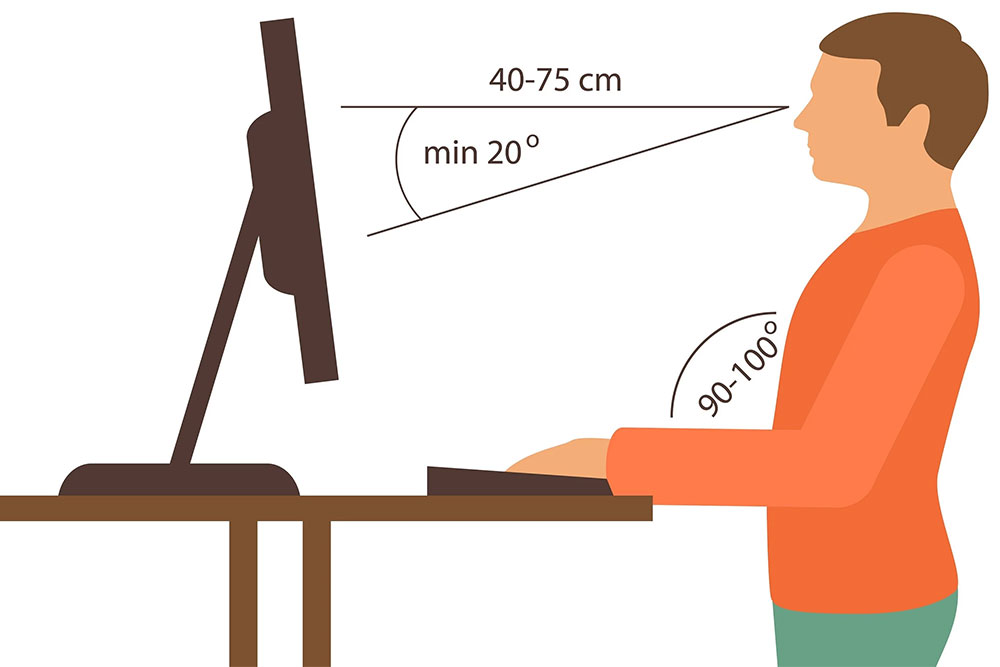The Brain
Sitting for prolonged periods of time on a daily basis, without standing or moving periodically, triggers a chain reaction of unhealthy side effects. Less blood and oxygen pumps throughout the body, which slows the release of important brain chemicals and affects concentration, mood, and decision-making.

Neck, Shoulders, and Back
The longer you sit, the harder it is to maintain good posture. The neck pushes forward and shoulders round. This hunched-over position causes strain to the cervical vertebrae along with muscle tension and even headaches.
Remaining sedentary weakens the abdominal muscles, which cannot properly support the spine. As the spine slumps, the soft discs between the vertebrae are stressed, resulting in disc degeneration and back pain. The chain reaction continues: A slumped spine impacts the lungs and diaphragm, which creates shallow breathing.
Vital Organs and Circulation
Without blood and oxygen moving freely, organs cannot function at optimal levels. Growing research shows a link between a sedentary lifestyle and cardiovascular disease as well as diabetes. Studies also show that routinely sitting for long periods of time can increase the risk of high blood pressure, high cholesterol, obesity, digestive problems, anxiety and depression, and even certain cancers. Poor circulation can also cause numbness in your legs, fluid retention, swollen veins, and contribute to life-threatening blood clots known as deep vein thrombosis.
Wiseman Health Take-Home Advice
Our goal is to provide our patients with positive health outcomes, and one of the ways to do this is to encourage everyone to sit less and move more. Here are a few ways to achieve better health through movement:
- Consider an adjustable-height work desk and try to stand more at work. Do not stand in one position longer than 10 minutes. When you do sit at a desk, be mindful of proper sitting posture. An easy, affordable solution for a standing work desk can be found here.
- If you sit for long periods of time every day, create a daily routine with multiple breaks—your goal should be to stand up and move every 20 minutes. Walk to a co-worker’s desk, rather than emailing or calling. Avoid the elevator when you can take the stairs. Take a walk at lunchtime. And when you break for food or drink, drink filtered water and eat sugar-free foods that aren’t processed.
- Increase your daily steps. Working up to 5,000 steps a day is an improvement. Walking 10,000 steps a day is even better! Walking is also a great weight-bearing exercise that strengthens bones. Use a fitness tracker to count steps and to elevate awareness of your daily activity.
- Walk outside: Natural environments can have a positive influence on your mental well-being and help increase your intake of Vitamin D from the sun.
- Limit how often you sit and watch TV. Stand up and move during commercials. It is best to watch TV or your laptop from a reclining or lying position.
Aim for a variety of exercise on a weekly basis (e.g., cardio, walking, yoga, or Pilates) and avoid chronic sitting. Remember: Increase physical activity throughout the day because exercise alone cannot undo the harmful effects of sitting.
Ekelund et al., (2015, January 14) Physical activity and all-cause mortality across levels of overall and abdominal adiposity in European men and women: the European Prospective Investigation into Cancer and Nutrition Study. ajcn.nutrition.org. Retrieved February 22, 2016 from http://ajcn.nutrition.org/content/early/2015/01/14/ajcn.114.100065.full.pdf+html
Bundrant, M. (2015, February 12) 20 creative ways to get 10K steps a day. naturalnews.com. Retrieved February 22, 2016 from http://www.naturalnews.com/048594_walking_exercise_physical_fitness.html#
Pearson, D. G. and Craig, T. (Published online 2014, October 21) The great outdoors? Exploring the mental health benefits of natural environments. Retrieved February 22, 2016 from http://www.ncbi.nlm.nih.gov/pmc/articles/PMC4204431/
Pullen, J. P. (2014, November 7) 5 Tips to Stay Healthy If You Sit at a Computer All Day. time.com. Retrieved February 23, 2016 from http://time.com/3566809/computer-health-tips/
Berkowitz, B. and Patterson, C. (2014, January 20) The health hazards of sitting.
washingtonpost.com. Retrieved February 22, 2016 from
https://www.washingtonpost.com/apps/g/page/national/the-health-hazards-of-sitting/750/
